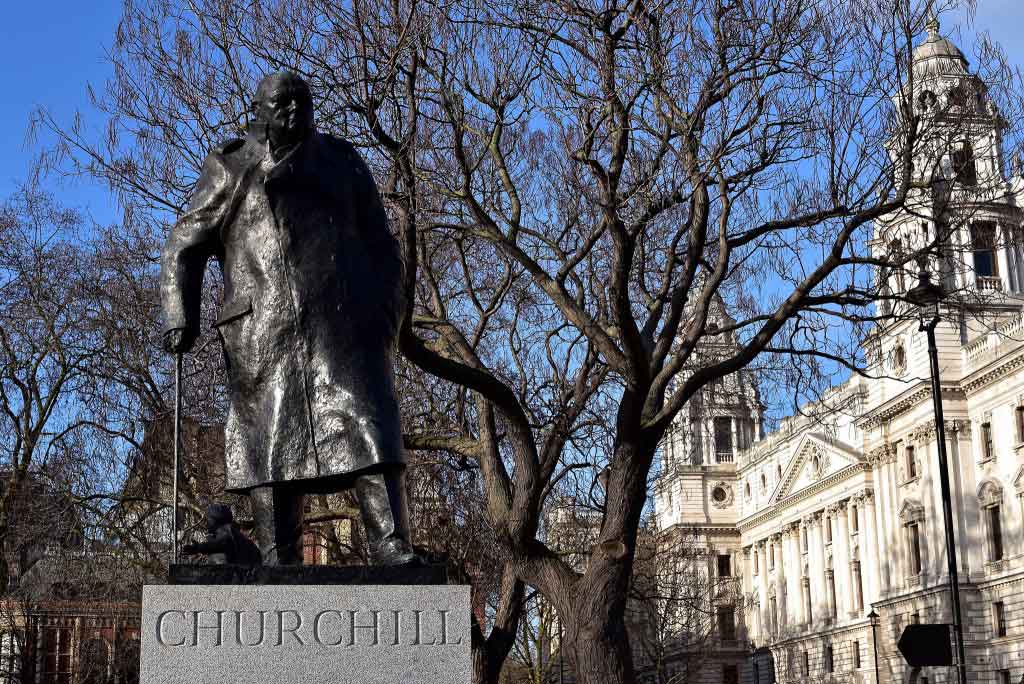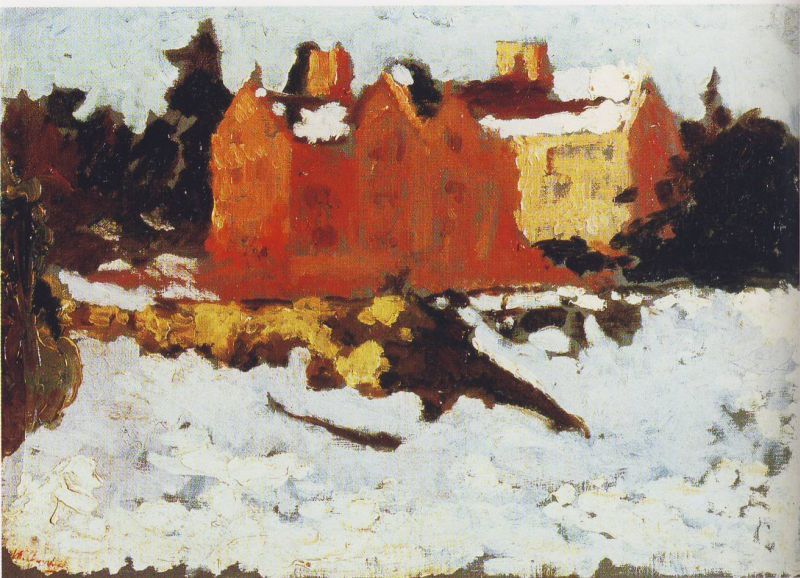
Finest Hour 178
An Impressionistic View: Winter Sunshine, Chartwell

Date: 1924/1925 -
March 27, 2018
Finest Hour 178, Fall 2018
Page 24
By Barry Phipps
Barry Phipps is an art historian and a Fellow of Churchill College, Cambridge. He wishes to thank Katherine Carter and the staff at Chartwell for assistance with this article.
The snow has stopped falling. Chartwell and the garden sit under a hefty, white cloak. The air is cold, quiet, and still. Sunshine dazzles, reflected by the snow and glowing from the house; only the shadows of trees and shrubs give respite from the intensity of the phosphorescent light.
The grounding colours of Winter Sunshine, Chartwell (1924/5) are greens, browns, and blacks, which are constructed to frame the view of the house between the foliage of shrubs and trees. The house is draped in russet colours of reds, oranges, and yellows, contrasting sharply with the background of deep shadows. The white paint is laid thick, with heavy layers foregrounding the vista, as if it had just fallen and now rests upon our view. An intense sense of sunlight shimmers across the scene. The colours are sensational rather than representative, lending the painting an emotional dimension. It is a work that prioritises subjectivity over observation.
The painting is one of Churchill’s most important. It is the work that elevated his hobby from personal pastime to critical acclaim. The story of how the painting was submitted anonymously to an amateur art exhibition is well-documented. On the reverse of the canvas is a letter signed by Oswald Birley relating how he, as one of the judges for the exhibition, awarded it first prize. He did so, however, against the wishes of one of the judges, Sir Joseph Duveen, who is said to have refused to believe it was by an amateur. It was only when the renowned art historian Kenneth Clark sided with Birley that the prize was duly awarded. Emboldened by this success, Churchill subsequently entered the same painting, under the pseudonym David Winter, to the Royal Academy’s Summer Exhibition, which gained him entry into the RA in 1947.

2025 International Churchill Conference
Churchill as Impressionist
As the the title indicates, the painting is a view of Chartwell under snow. Churchill purchased the house in 1922, in part for the panorama it commanded over the Weald of Kent. As David Coombs has noted, “[The] new house and the marvellous views it offered often inspired his brush.” Despite the commanding views over the Kent countryside, for Winter Sunshine, Chartwell Churchill turned his back on the landscape and focused his attention upon his home. The resulting canvas is a view of Chartwell seen from directly outside the studio looking up towards the house. One can imagine the artist painting in the biting cold, furiously trying to capture the moment with the sunshine reflecting off the snow, creating this intense and luminous picture.
Leaving the history of the painting aside, Winter Sunshine, Chartwell tells us much about Churchill’s broader artistic inspirations, influences, and ambitions. The painting is an attempt to capture the fleeting moment in time and the sensation the scene creates in the onlooker. To this end, the work has been described as one of the most impressionistic paintings by Churchill. Yet, what is meant by the term “impressionistic” in this context?
In an art historical sense, the term “impressionism” was coined by the French critic Louis Leroy, in his review of L’Exposition des Impressionnistes, which was the first group exhibition to include new works by Claude Monet, Auguste Pierre Renoir, Camille Pissarro, and Alfred Sisley, in Paris during 1874. Monet exhibited the work that was to give the group its lasting name, Impression, Sunrise (1872). Impressionism had been developed in France by some of the most advanced painters of the nineteenth century. Rather than painting in a studio, the so-called “Impressionists” aimed to capture the momentary and transient effects of natural light by working quickly, in front of their subjects, en plein air. This result was a heightened awareness of atmosphere, colour, and light, and the shifting patterns of the natural landscape. Brushwork was rapid and broken into separate dabs in order to render the fleeting quality of daylight. In addition to their new, radical techniques, the bright colours of Impressionist canvases were shocking for eyes accustomed to the more sober tones of Academic painting. Many of the artists chose not to apply the thick golden varnish that painters customarily used to tone down their works. The paints themselves were more vivid too. The period saw the development of synthetic pigments for artists’ paints, providing vibrant shades of blue, green, and yellow that painters had never used before.
The importance of the Impressionists and their followers on the work of Churchill, together with the modern movement more generally, cannot be over-emphasised, as made clear in his Painting as a Pastime:
Have not Manet and Monet, Cézanne and Matisse, rendered to painting something of the same service which Keats and Shelley gave to poetry after the solemn and ceremonious literary perfections of the eighteenth century? They have brought back to the pictorial art a new draught of joie de vivre; and the beauty of their work is instinct with gaiety, and floats in sparkling air.
I do not expect these masters would particularly appreciate my defence, but I must avow an increasing attraction to their work.
As David Coombs has insightfully noted, Churchill was always interested in the techniques of the masters and he copied a number of paintings, as was the custom of many artists in the past schooled in this practical way of learning; his painting in 1935 entitled Bay near Marseilles (C330), appears in fact to be a copy of Monet’s L’Ally Point, Low Tide, 1882.
The Monet Connection
In addition to his mastery of landscape painting, Monet also had a talent for capturing the aftermath of heavy snowfalls. His scenes were primarily personal records of familiar places that had been suddenly transformed, revealing a new beauty. As these were fleeting moments, Monet would draw upon all of his painterly skills to capture the scene rapidly, its new guise altered by snow showers. The best examples of this aspect of his work are in those the artist made during his visit to the fjordside village of Sandvika, about nine miles south of Christiania (now Oslo), Norway during the winter of 1895. There he sought out quiet places in order to paint the transformations winter had brought about. Monet spent two months exploring the country on foot and by horse-drawn sleigh, setting up his easel outside to paint, in temperatures down to -20° C. On one occasion he wrote to a friend in Paris saying: “I painted part of the day today, while it was snowing continually: you would have laughed to see me entirely white, my beard covered in icy stalactites.”
The influence of Monet and those who followed Impressionism is evident in Churchill’s earlier work and remained an enduring influence throughout his practice. This is made clear in his own account of those who inspired his paintings:
Chance led me one autumn to a secluded nook on the Côte d’Azur, between Marseilles and Toulon, and there I fell in with one or two painters who revelled in the methods of the modern French School. These were disciples of Cézanne. They view Nature as a mass of shimmering light in which forms and surfaces are comparatively unimportant, indeed hardly visible, but which gleams and glows with beautiful harmonies and contrasts of colour….Now I must try to represent it by innumerable small separate lozenge-shaped points and patches of colour—often pure colour—so that it looked more like a tessellated pavement than a marine painting. It sounds curious. All the same, do not be in a hurry to reject the method. Go back a few yards and survey the result. Each of the little points of colour is now playing his part in the general effect….
Although originating in France, Impressionism had great influence overseas, and included artists working in Britain, amongst them Walter Richard Sickert. When Churchill was Chancellor of the Exchequer during the 1920s, we find him taking detailed advice and instruction from Sickert. It was the latter who passed on his enthusiasm for French painters such as Degas, Corot, and others. From then on, Churchill was to spend years scrutinising the works of many painters, including J. M. W. Turner, widely regarded as the founding influence of the Impressionists, and Camille Pissarro (whom Clementine had met in Paris). What these painters have in common is the subject of the famous remark by Cézanne that “Painting from Nature is not copying the object; it is realising one’s sensation.” And, as a poem is made of words arranged on a page, then painting too should be seen as ordered patches on a flat blank surface. Here painting’s task was not to describe but to express. By this means, colour could claim the sensibility of emotion itself.
The Passionate Painter
Through Winter Sunshine, Chartwell we glimpse a different image of Churchill the painter. Far from being the stalwart of traditional values in art, as he is too often depicted, Churchill was deeply interested in and influenced by the “masters” of modern art. Yet, let us be clear, no one is suggesting that his work matched the innovative artistic heights that Monet and his contemporaries achieved in their pursuit of the world seen differently—to poeticise the effects of light and colour. The lightness of Churchill’s painting doesn’t lie in his technique. He battled with technique, and so his lightness is of a different kind. By relinquishing the pursuit of technique he gained a carefreeness that allowed him a lightness to enjoy painting for its own pleasure.
Commentators have claimed that Churchill was not a great painter. This is true, at least if by “great” painter they mean someone to whom painting has come easily, someone who has shown talent at an early age and then followed a path of major innovation allied to outstanding technique. Painting did not come easily to Churchill. Like almost everything in his life, he fought passionately for the things he believed in, and painting was certainly one of those things.
Subscribe
WANT MORE?
Get the Churchill Bulletin delivered to your inbox once a month.



